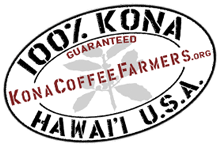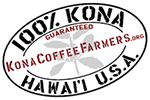The Independent Voice
“Best Agricultural Newsletter in Hawaii”
Newsletter of the Kona Coffee Farmers Association
August 2020
PO Box 5436 Kailua Kona Hawaii 96745 USA
CBB Pesticide Subsidy Program
KCFA 2020 Candidate Questionnaires
CENSUS
USDA Reimbursement for Transportation Cost
A Coffee Quote
CTAHR Mini-Conference: Soil Health & Sustainable IPM
Food for Thought
10 Surprising Uses for Coffee
Recipe: Affogato
Editor – Clare Wilson
New CBB Study
The USDA researchers at PBARC have released a new publication examining CBB levels in four different types of coffee: feral; abandoned; poorly managed; and well-managed farms. This is one of the many projects that have come out of three years of area-wide data collection from farms in Kona and Ka’u.
Poorly managed, abandoned and feral coffee sites on the island have long been thought to harbor coffee berry borer (CBB) populations, which then negatively impact neighboring coffee farms. In the study, PBARC sought to quantify CBB abundance in these various sites. They collected data on CBB flight activity (via traps), fruit production and fruit infestation by CBB in eight well-managed farms as well as other sites that were either poorly managed, abandoned or feral (wild) coffee. Sites were sampled bi-weekly over a period of 2 years from 2016 to 2017.
They found that CBB flight activity was significantly higher in poorly managed sites relative to abandoned and feral sites, but was not significantly different from well-managed sites. Coffee production in well-managed farms was significantly higher than in abandoned and feral sites, but was not significantly different from poorly managed farms. CBB infestation in poorly managed sites was significantly higher than that observed in well-managed, abandoned and feral sites. They estimated an average load of 11–25 CBB per branch at poorly managed sites, compared to 3–9 per branch at well-managed sites, 1–16 per branch at abandoned sites and 1–3 per branch at feral sites. Findings suggest that poorly managed sites should be prioritized for implementation of CBB control measures as part of a landscape-level integrated pest management (IPM) program.
To see the entire study go to: https://onlinelibrary.wiley.com/journal/14390418 and then “search” for: DOI: 10.1111/jen.12804
–Submitted by Suzanne Shriner
CBB Pesticide Subsidy Program
Aloha Coffee Farmers!
The new HDOA CBB Pesticide Subsidy Program application is up! It’s a great time to apply before the coffee harvest season gets busy! We are continuing to make the application Covid19 safe, so apply online, by email or by snail mail. Start here: https://hdoa.hawaii.gov/pi/main/cbbsubsidy/
This application applies to receipts from 7/1/19 – 6/30/20 which you can scan/photo and email in or mail in. If you have questions, please email hdoa.cbb@hawaii.gov or call 808-323-7578.
-Melanie Bondera
CBB Subsidy Program Coordinator
KCFA 2020 Candidate Questionnaires
On June 24 and 25 KCFA sent questions on issues of importance to coffee farmers to candidates seeking to represent West Hawaii residents in the State Legislature, the Hawaii County Council, and the US House of Representatives. The candidates were asked to state positions on a 51% minimum for Hawaii coffee blends, requiring fair disclosure on ready-to-drink coffee products using Hawaii regional names, and protecting coffee farmers from introduction of coffee pests and diseases. It is heartening to see the breadth and strength of the candidates’ stated support for coffee farmers. Links to the questions and the responses from the candidates are set forth below.
Prior to casting votes in the August 8 primary election and in the November 3 general election, we encourage coffee farmers and members of the public to review the candidate responses. Remember that this year voting in Hawaii is by mail. Ballots for the August 8 primary election are being sent now. BE SURE TO MAIL IN YOUR BALLOT.
Here are the links to the questionnaires:
Hawaii House of Representatives –click HERE> https://konacoffeefarmers.org/topics-of-interest/legislative/hawaii-house-of-representatives-2020/
Hawaii County Council -click HERE> https://konacoffeefarmers.org/topics-of-interest/legislative/hawaii-county-council-2020/
US House of Representatives, District 2 – click HERE> https://konacoffeefarmers.org/topics-of-interest/legislative/us-house-of-representatives-dist-2-2020/
–Submitted by Bruce Corker
 To File ONLINE: https://my2020census.gov
To File ONLINE: https://my2020census.gov
Hawaii Agriculturalists,
More info here
Sharen L. Truex Nakashima
Partnership Specialist Honolulu
Los Angeles Regional Census Center
U.S. Census Bureau
sharen.l.truex.nakashima@2020census.gov
________________________________________________________________________________________________________________________________________________
USDA Reimbursement for Transportation Cost
The U.S. Department of Agriculture (USDA) Farm Service Agency (FSA) has announced that the enrollment period for the Reimbursement Transportation Cost Payment Program (RTCP) click here>> (https://tinyurl.com/y34rhjdt) for fiscal year 2020 began on July 13 and will run through Sept. 4.
The Further Consolidated Appropriations Act 2020, reauthorized RTCP and allows farmers and ranchers in Hawaii to recover any costs to transport agricultural commodities or inputs (fertilizer, gasoline, equipment) used to produce an agricultural commodity.
RTCP payments are calculated based on the costs incurred for transportation of the agricultural commodity or inputs during a 12-month period, subject to an $8,000 per producer cap per fiscal year. If claims for payments exceed the funds available from the program for a fiscal year, payments will be reduced on a pro-rata basis.
Farmers and ranchers interested in participating in RTCP can obtain applications and other documents by calling the local FSA county office in Hilo at (808) 933-8381
–Submitted by Suzanne Shriner
A Coffee Quote
Thomas Jefferson “Coffee, the favorite drink of the civilized world.”
—-Submitted by Carolyn Witcover
CTAHR Mini-Conference: Soil Health & Sustainable IPM
CTAHR is hosting a VIRTUAL SOIL HEALTH & SUSTAINABLE IPM MINI-CONFERENCE on Tuesday, August 4th from 4:30 – 6:30 pm. Registration link is in the attached flyer>>> here.
Please note the workshop is limited to producers. The mini-conference subject matter and terms are suited for those that are already familiar with soil health & sustainable IPM.
Can contact UH Koon-Hui Wang koonhui@hawaii.edu with questions.
—Submitted by John Koontz
Food for Thought
“The idea that Alzheimer’s is entirely genetic and unpreventable is perhaps the greatest misconception about the disease,” says Gary Small, M.D., director of the UCLA Center on Aging.
Researchers now know that Alzheimer’s like heart disease and cancer, develops over decades and can be influenced by lifestyle factors including cholesterol, blood pressure, obesity, depression, education, nutrition, sleep and mental, physical and social activity.
The big news:
Mountains of research reveals that simple things you do every day might cut your odds of losing your mind to Alzheimer’s.
In search of scientific ways to delay and outlive Alzheimer’s and other dementias, I tracked down thousands of studies and interviewed dozens of experts. The results in a new book: 100 Simple Things You Can Do to Prevent Alzheimer’s and Age-Related Memory Loss (Little, Brown; $19.99).
1. Have coffee.
In an amazing flip-flop, coffee is the new brain tonic. A large European study showed that drinking three to five cups of coffee a day in midlife cut Alzheimer’s risk 65% in late life. University of South Florida researcher Gary Arendash credits caffeine: He says it reduces dementia-causing amyloid in animal brains. Others credit coffee’s antioxidants. So drink up, Arendash advises, unless your doctor says you shouldn’t
–submitted by Mary Lou Moss

……..someone stole my coffee cup from work this morning. Seems that I’ll have to go to the police station and look at some mug shots.
10 Surprising Uses for Coffee that Don’t Involve Drinking It
“For the people who manage to make it through each day without tossing back cup after cup of Mother Nature’s deliciously bitter bean water, coffee might seem totally useless. And even if you do run on java, you may not realize how useful those leftover grounds can be. From fertilizing your garden to making boxed brownies taste homemade, here are 10 ways to make the most of coffee without drinking a drop…”
By CoffeeBUZZPosted on July 15, 2020 https://coffeetalk.com/coffeebuzz/07-2020/68711/
–Submitted by Cecelia Smith
Recipe: Affogato

The simplest of recipes. Incredibly delicious!
HOW TO MAKE AN “AFFOGATO”: To a small chilled bowl add a scoop of vanilla ice cream; over the ice cream pour a shot of hot espresso; watch and patterns and currents as the espresso interacts with the ice cream; then with a spoon, or sipped from the bowl, enjoy this delicious Italian treat.
Created in Italy many years ago, “affogato” (Italian for “drowned”) is now becoming popular around the world. There is a spirited debate over whether affogato is a dessert or a beverage. But however it is characterized, do not wait after the expresso is poured; consume the affogato before the ice cream melts. Although Italian espresso is traditionally made with dark roasted robusta, the taste of an affogato made with a lighter roast 100% Kona coffee is unmatched.
–submitted by Bruce Corker
Recipes Wanted! If any of you have coffee recipes that you would like to share, please submit them to the editor: clare@huahuafarm.com
LET US KNOW WHAT YOU THINK! >> Write to us. We welcome Letters to the Editor up to 150 words. We reserve the right to edit for clarity and length. Include your name and email address >> Email: info@KonaCoffeeFarmers.org with SUBJECT: Commentary.



 To File ONLINE:
To File ONLINE: